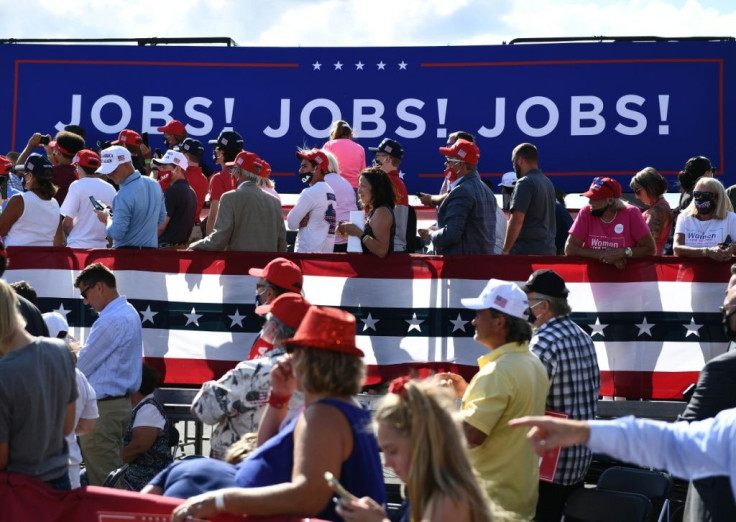US Sees Surprise Dip In Unemployment Rate To 6.9% In October
The US unemployment rate unexpectedly dropped to 6.9 percent in October, a decline of a full point ahead of the presidential election, though the economy is far from healed and rising coronavirus cases could undo the progress.
The decrease came as the economy regained 638,000 jobs last month, according to a Labor Department report released Friday, far more than analysts had been expecting as hard-hit sectors continued hiring despite Congress's failure to pass another spending package to aid the recovery.
The downturn caused by the coronavirus pandemic was considered one of the main issues facing voters when they went to polls this week to choose whether to give President Donald Trump a second term or replace him with challenger Joe Biden, who leads in key states as vote counting continues.
But Rubeela Farooqi of High Frequency Economics warned October's momentum may not last long.
"The risk is high of a deceleration in job gains from rising virus transmissions that will result in business closures and job losses," she said in an analysis.
"Overall, diminishing job growth and missing fiscal support will likely weigh on incomes and spending and will slow the economic rebound going forward."
The data sparked another salvo over how large of a spending package will be needed from Congress.
Republican Senate Majority Leader Mitch McConnell told reporters the jobs report "reinforces the argument that I've been making for the last few months, that something smaller... is more appropriate."
Democrats controlling the House of Representatives were pushing for another $2.2 trillion package, with measures to contain the virus and help for state and local governments -- which shed 130,000 jobs in October, almost entirely in education.
House Speaker Nancy Pelosi said McConnell's call for a smaller bill "doesn't appeal to me at all, because they still have not agreed to crush the virus."
All races and age groups saw their unemployment rates decline, the Labor Department said, and the improvement in overall payrolls came despite a 268,000 drop in government jobs largely due to temporary census workers being let go.
Sectors that saw mass layoffs when business shutdowns began earlier this year to stop the spread of Covid-19 saw improvement in October, with leisure and hospitality adding 271,000 jobs, the majority of which were in food and drinking places.

Retail traders added 104,000 jobs, professional and business services 208,000 and construction 84,000.
"The economy is finding new ways to do business, and is hiring back workers on furlough because of Covid-19 more quickly than expected," said Robert Frick of Navy Federal Credit Union.
The gains brought the labor force participation rate, which indicates the share of working age population who have jobs or are actively looking for work, up slightly to 61.7 percent last month, but that is its lowest level since 1977.
Other parts of the report gave a mixed verdict on the world's largest economy, which was boosted by a massive $2.2 trillion spending package enacted in March, most aspects of which have since expired.
The number of people on temporary layoff -- such as workers whose employers have closed due to Covid-19 -- declined by 1.4 million to 3.2 million, perhaps indicating people returning to work as businesses reopened.
But the number of permanent job losers was at 3.7 million last month, 2.4 million above pre-pandemic level.
And the number of people jobless for at least 27 weeks grew by 1.2 million, indicating some workers were having trouble finding employment.
The share of people working part time because they cannot find a full-time job also increased last month after falling in September, according to the report.
"While the economy has reclaimed 12 million jobs from the trough of the crisis in April, it has barely passed the halfway mark in what promises to be a grueling marathon," said Gregory Daco of Oxford Economics.
He noted that if people who dropped out of the labor force or were misclassified in the report are factored in, the unemployment rate is likely closer to nine percent.
Congress tried for months to find an agreement with the Trump administration on another stimulus package, but talks fell apart.
Daco predicted further gridlock in Congress and warned of "demand being restrained by rising Covid-19 infections and slower employment gains (that prove) insufficient to offset lapsing fiscal aid."
© Copyright AFP {{Year}}. All rights reserved.





















